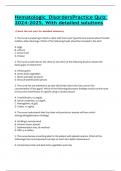Exam (elaborations)
Hematologic Disorders Practice Quiz . With detailed solutions
- Course
- Institution
Hematologic Disorders Practice Quiz . With detailed solutions (Check the last part for detailed solutions) 1. The nurse is preparing to teach a client with microcytic hypochromic anemia about the diet to follow after discharge. Which of the following foods should be included in the diet? A....
[Show more]



